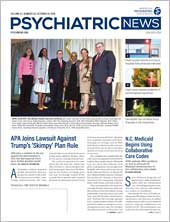The Centers for Disease Control and Prevention (CDC) has published a “technical package” of suicide-prevention strategies that can be used at the state and community levels as well as by psychiatrists and mental health professionals.
The 67-page document, titled “Preventing Suicide: A Technical Package of Policies, Programs and Practices,” describes a select group of strategies based on the best available evidence. These strategies are described in seven chapters that cover the topics of strengthening economic supports, strengthening access and delivery of suicide prevention care, creating protective environments, promoting connectedness, teaching coping and problem-solving skills, identifying and supporting people at risk, and lessening harms and preventing future risk.
“States and communities already engaged in suicide prevention can use this technical package to assess their activities and see if there are areas in which to expand their efforts,” said Deb Stone, Sc.D., M.S.W., M.P.H., in comments to Psychiatric News. She is a behavioral scientist in the Division of Violence Prevention at the CDC’s National Center for Injury Prevention and Control. “For states and communities who have not begun work in the area of suicide prevention, this technical package can help guide decision making and prevention planning.”
The strategies in the package include those with a focus on preventing suicide and reducing risk as well as approaches to lessen the immediate and long-term harms of suicidal behavior for individuals, families, communities, and society at large.
Although primarily intended for policymakers, the technical package can be used by psychiatrists and mental health clinicians. “Psychiatrists may be able to use the package in several ways—by working with their local community organizations to make sure that evidence-based programs are being implemented and helping to raise awareness about the programs and policies described in the technical package,” Stone said. “The broad range of strategies in the technical package requires collaboration across community sectors. Psychiatrists and other health and mental health professionals are critical to the implementation of evidence-based treatments and practices such as Collaborative Assessment and Management of Suicidality, dialectical behavior therapy, and other forms of cognitive-behavioral therapy.”
Among the experts who reviewed the CDC document was APA member Christine Moutier, M.D., chief medical officer of the American Foundation for Suicide Prevention (AFSP).
In comments to Psychiatric News, Moutier said the technical package builds on a similar document produced by the AFSP’s Action Alliance, “Transforming Communities: Key Elements for the Implementation of Comprehensive Community-Based Suicide Prevention.” The latter outlined very broad public health strategies—planning, communication with stakeholders in the community, aligning activities to the local culture, and ensuring sustainability for long-lasting change.
She said the CDC technical package is a more detailed “toolkit” describing specific strategies that have been shown to reduce suicide.
Moutier highlighted the need to reduce access to lethal means among people at risk for suicide. In the chapter titled “Create Protective Environments,” the technical package outlines the importance of safe storage of medications, firearms, and other household products that can be used in suicide.
“Such practices may include education and counseling around storing firearms locked in a secure place (e.g., in a gun safe or lock box), unloaded and separate from the ammunition; and keeping medicines in a locked cabinet or other secure location away from people who may be at risk or who have made prior attempts,” according to the technical package.
Moutier said psychiatrists and other physicians have a critical role in providing such counseling. “If we educate all gun owners that the presence of a gun in the home increases the risk of suicide and we also teach them basic prevention strategies such as safe storage, we have a logical reason to believe it will reduce suicide in the population,” she said.
She urged psychiatrists to seek out extra training in suicide risk assessment and evidence-based treatments and to familiarize themselves with the CDC technical package.
“It really represents how far we have advanced in community-based suicide prevention,” Moutier said. ■
“Preventing Suicide: A Technical Package of Policies, Programs, and Practices” can be accessed
here. “Transforming Communities: Key Elements for the Implementation of Comprehensive Community-Based Suicide Prevention” is available
here.

